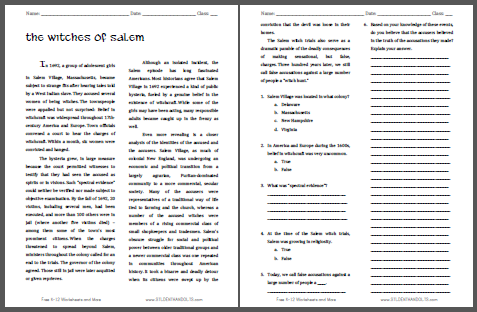| The Witches of Salem Reading with Questions |
|---|
| www.studenthandouts.com ↣ American History ↣ American History Readings |
 In 1692, a group of adolescent girls in Salem Village, Massachusetts, became subject to strange fits after hearing tales told by a West Indian slave. They accused several women of being witches. The townspeople were appalled but not surprised: Belief in witchcraft was widespread throughout 17th-century America and Europe. Town officials convened a court to hear the charges of witchcraft. Within a month, six women were convicted and hanged.
In 1692, a group of adolescent girls in Salem Village, Massachusetts, became subject to strange fits after hearing tales told by a West Indian slave. They accused several women of being witches. The townspeople were appalled but not surprised: Belief in witchcraft was widespread throughout 17th-century America and Europe. Town officials convened a court to hear the charges of witchcraft. Within a month, six women were convicted and hanged.The hysteria grew, in large measure because the court permitted witnesses to testify that they had seen the accused as spirits or in visions. Such "spectral evidence" could neither be verified nor made subject to objective examination. By the fall of 1692, 20 victims, including several men, had been executed, and more than 100 others were in jail (where another five victims died)—among them some of the town's most prominent citizens. When the charges threatened to spread beyond Salem, ministers throughout the colony called for an end to the trials. The governor of the colony agreed. Those still in jail were later acquitted or given reprieves. Although an isolated incident, the Salem episode has long fascinated Americans. Most historians agree that Salem Village in 1692 experienced a kind of public hysteria, fueled by a genuine belief in the existence of witchcraft. While some of the girls may have been acting, many responsible adults became caught up in the frenzy as well. Even more revealing is a closer analysis of the identities of the accused and the accusers. Salem Village, as much of colonial New England, was undergoing an economic and political transition from a largely agrarian, Puritan-dominated community to a more commercial, secular society. Many of the accusers were representatives of a traditional way of life tied to farming and the church, whereas a number of the accused witches were members of a rising commercial class of small shopkeepers and tradesmen. Salem's obscure struggle for social and political power between older traditional groups and a newer commercial class was one repeated in communities throughout American history. It took a bizarre and deadly detour when its citizens were swept up by the conviction that the devil was loose in their homes. The Salem witch trials also serve as a dramatic parable of the deadly consequences of making sensational, but false, charges. Three hundred years later, we still call false accusations against a large number of people a "witch hunt." Questions with answers in bold: 1. Salem Village was located in what colony? a. Delaware b. Massachusetts c. New Hampshire d. Virginia 2. In America and Europe during the 1600s, belief in witchcraft was very uncommon. a. True b. False 3. What was "spectral evidence"? It was testimony that a person had seen the accused as spirits or in visions. 4. At the time of the Salem witch trials, Salem was growing in religiosity. a. True b. False 5. Today, we call false accusations against a large number of people a witch hunt. 6. Based on your knowledge of these events, do you believe that the accusers believed in the truth of the accusations they made? Explain your answer. Answers will vary. Click here to print this worksheet. |
 |  |  |  |  |  |
| Colonial Period Books and Films | Colonial Period Learning and Study Games |
| Colonial Period Image Galleries | Colonial Period Outlines and PowerPoints |
| Colonial Period Miscellany | Colonial Period Worksheets |
| www.studenthandouts.com ↣ American History ↣ American History Readings |








